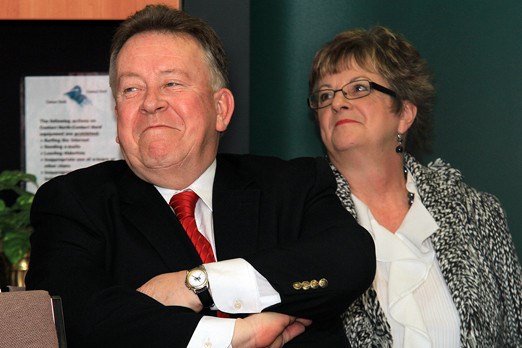The province is touting the release of its Growth Plan for Northern Ontario as a significant key to the future of the region.
Not everyone is as enthusiastic.
Thunder Bay Mayor Keith Hobbs said while he likes the direction, the 50-page report comes up short on substance.
“It’s a 25-year plan and it’s got a lot of potential, so we’ll see how it rolls out,” said Hobbs, briefed earlier in the week about the document at the Ontario Good Roads Association conference.
“I would have liked to see a little more meat in it. But it’s a great start, it’s a great framework, it’s just going to be up to the parties to get some implementation going.”
Hobbs was particularly miffed that energy policies were only mentioned in passing, only touching on programs the province has already put in place and nothing about the possibility of a separate Northern Ontario energy rate.
“I would have liked to have seen a little more substance on transmission and distribution and costing of hydro for the Northwest and the North. But you know, we can work on that. There is a framework to start things like that.”
Thunder Bay Chamber of Commerce president Howard Wilson said he’ll need time to go through the report and he is pleased that some of the wording has changed since the first draft was released in late 2009.
Wilson said he wanted to see backing for maximizing the value of the region’s resources.
“Language very similar to that is in there. It’s a small point, but that’s a guiding principal. If you’re not going to maximize the value of the resources that we have to grow our economy, nothing else really flies.”
But until implementation begins, he’s not holding out hope that everything will get done, especially with an election looming in October.
“I’ve seen 25-year plans before,” he said, adding he’ll be petitioning all parties to stay onside ahead of the vote.
“There was one that was introduced I think in 1990 that didn’t survive two months.”
Three concrete plans did emerge on Friday as a result of the extensive consultation with northerners since the Growth Plan was first announced in May 2007 through the province’s Open Ontario Plan.
The first is the establishment of a Northern Policy Institute, made possible through a $5-million grant from the Northern Ontario Heritage Fund Corporation. The second is a long-term strategy to develop a multi-modal transportation system for the North involving roads, air, rail and water. Lastly it calls for northern communities and business leaders to come together to support regional economic planning, innovation and entrepreneurship.
Northern Development Minister Michael Gravelle called it a plan created by Northerners, for Northerners that will guide investment decisions by the province for the next 25 years.
“That’s very much what the key to this will be. Northerners told us what they thought the priorities needed to be to develop and economic vision for Northern Ontario, and this document delivers on that,” Gravelle said. “We have some very specific initiatives that I know are getting some excitement.”
The report identifies six theme areas to concentrate further consultation, energy and studies on: the economy, people, communities, infrastructure, the environment and Aboriginal peoples.
Sub-sections of the document discuss things like co-ordinated, strategic infrastructure investments, sustainable development of natural resources, economic development in Aboriginal communities and creating a culture of innovation and entrepreneurship.
It’s not good enough said MPP Howard Hampton (NDP, Kenora).
“There is no growth plan. After four years of talk from the (Dalton) McGuinty Liberals, basically what they’re proposing now is more years of talk. They’re talking about establishing a policy institute where people will sit around and talk. They’re talking about planning for 25 years in terms of highways and transportations,” Hampton said.
“People don’t want to see more talk and study. The reality is across Northern Ontario people are losing their jobs now. Communities are seeing their economies decline now. The last thing out-of-work workers, the last thing that hard-pressed communities need, are more talks and more studies.”
However, the report was welcomed by at least one regional organization.
Ron Nelson, president of the Northwestern Ontario Municipal Association, called it a significant step forward on the path toward a more prosperous and diversified region.
He said it includes much of what was asked for last decade by Common Voice Northwest.
“We’re excited about the opportunity, especially the northern institute. That’s going to give us the tools that we need to discuss forestry and help in giving direction to all levels of government on where we need to move forward in Northwestern Ontario,” Nelson said.
Nelson isn’t too concerned about the lack of concrete plans in the document.
“It’s a framework that is a timeline of 25 years. What we’re excited about is that … we are going to be at the table as the regulations and the legislation starts getting put together. That’s very exciting because we are able to have our input right directly.”
A full version of the report can be downloaded here.
Sign in or register
- Messages
- Post a Listing
- Your Listings
- Your Profile
- Your Subscriptions
- Your Likes
- Your Business
- Support Local News
- Payment History
Registered Users
Already have an account?
New Users
Create a free account.
